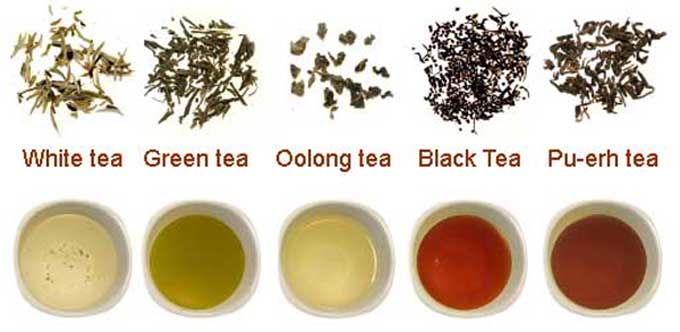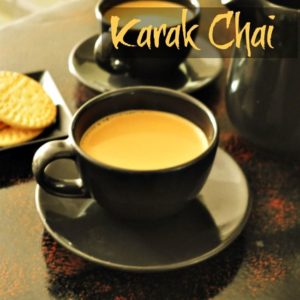Tea
Definition of Tea
An aromatic beverage prepared from tea leaves by soaking them in boiling water.
Types of tea
Basic varieties
All tea comes from only one plant called Camellia sinensis. However based on the type of tea leaves picked and the level of oxidation or processing, tea is classified into five main types: Black, Green, Oolong, White and Pu-erh.




 Pu-erh tea is a special type of tea that comes from the Yunan province of China and is known for its earthy flavour. It is made out of tea plucked from wild tea trees rather than cultivated bushes and the leaves go through microbial fermentation by pressing the raw leaves together and then storing them for maturity. Pu-erh tea can be either black or green depending on the level of oxidation allowed in the process.
Pu-erh tea is a special type of tea that comes from the Yunan province of China and is known for its earthy flavour. It is made out of tea plucked from wild tea trees rather than cultivated bushes and the leaves go through microbial fermentation by pressing the raw leaves together and then storing them for maturity. Pu-erh tea can be either black or green depending on the level of oxidation allowed in the process.
Flavoured tea
Flavoured teas are created by adding flowers, herbs, fruits and other natural flavours to black, green or oolong teas. Some of the more common types of flavoured teas include:




Herbal infusions (Tisanes)
In addition to the above, herbal infusions from other plants are also sometimes referred to as tea, although not to the purists. The correct term for any non-tea beverage is tisaneor just herbal infusion. Examples include chamomile, peppermint, rooibos, etc.

Some examples of fruit teas that you can find in our shop include Tropical Burst which contains natural dried apple pieces, hibiscus, rosehip and natural flavours; and Spicy Apple which contains dried apple, hibiscus, ginger, cardamom, cinnamon, cloves, pepper, stevia, cornflower petals and natural flavours.

One of the most common herbal tea made out of flowers is Camomile tea which is made of dried camomile flowers and is proven to be an effective antioxidant. Another example is Rosebud tea made of dried rosebuds which is proven to protect the skin against signs of ageing.

Examples include Yerba Mate which is made from the leaves of the holly tree of the South Amerian rain-forests and one of the few herbal teas that has the caffeine content of Arabica coffee. Another very popular herbal tea made out of non-tea leaves is the Rooibos tea. Grown exclusively in South Africa, the leaves of the Rooibos plant turn red after processing and is caffeine free.
CHAI KARAK
Head to any Chai Karak joint in the early hours of the morning or late at night and you will find endless rows of cars lining up for what seems to be just a small cup of inexpensive tea. The creamy, fragrant Chai Karak stands strong as one of the drinks that is gaining popularity in the Khaleeji region. Currently one of the most popular hot drinks in the Oman, UAE and Qatar, its humble beginnings actually lie in the South Asian countries of India and Pakistan.
Known as ‘kadak chai’ or ‘masala chai’, which roughly translates to strong tea, versions of chai karak are prepared in South Asian homes daily. A blend of black tea, milk, sugar and cardamom, it is prepared by boiling this combination together on a low flame. Although no one really knows how ‘kadak chai’ became Chai Karak, the most likely idea is that South Asian workers in the region brought with them their love of milky tea when they left their homes.

In the Indian subcontinent, the tea culture can be traced back to colonial times and now tea is vital in every household pantry. The tea of the subcontinent has not completely translated to become chai karak however. Unlike traditional South Asian ‘masala chai’, chai karak uses just one spice, while ‘masala chai’ can often include a variety of spices like ginger, peppercorn or cloves.
The regionally popular Chai Karak instead developed into a drink that reflects local tastes by combining a spice common to both cultures; cardamom, as well as a mutual love for the strong flavor of black tea. In the UAE and Qatar, numerous small cafeterias serve thousands of cups of this comfort drink daily, at the beep of a car horn, to young and old, both local and expats.
Whether it joins them on a simple stroll with a loved one or while driving around and catching up with friends, this simple drink has become an integral part of local culture. A truly addictive flavor, it has even found its way into cupcakes and ice cream!
Want to attempt recreating this drink at home? Try this simple recipe below:
- Combine a teaspoon of loose black tea and crushed cardamom with a cup of boiling water and boil for a couple of minutes.
- Remove from the heat; add milk till the tea becomes a creamy brown colour and sugar to your taste.*
- Place back on the heat and boil for a further two minutes.
- Serve hot!
*Note: Some recipes use sweet condensed milk instead of regular milk and sugar to get an even richer taste. To intensify flavor, you can add a few saffron threads, ginger or any other of your favorite spices.
1. Barley Tea
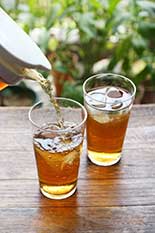
Barley tea enjoys most popularity in the East, and it’s a staple drink in China, Japan, and Korea.
In Japan, it goes by the name ‘mugicha’ and Koreans call it ‘boricha’; many families drink it on a daily basis. The drink is made by toasting barley, and then boiling it for approximately 20 minutes.
Traditionally served cold with ice, it is especially popular as a summer drink and many people drink it like water.
The tea has recently enjoyed greater worldwide popularity, and it is easy to find online or in specialist stores.
Since the tea is a grain-infusion made with roasted barley, it is not a “true” tea.
In regard to flavor, it tastes nutty, smoky and slightly bitter. There is very limited research on potential health effects of the drink.
2. Black Tea

Made with the leaves of the Camellia sinensis plant, black tea is a true tea.
It’s also one of the most popular drinks in the world, particularly so in Great Britain and Ireland. In fact, Brits drink approximately 165 million cups of black tea every single day.
Due to the slightly bitter and astringent taste, many people enjoy the drink together with a small amount of milk.
How Do Black and Green Teas Differ?
There are a few differences between green and black tea; the major one is that black tea requires a lengthier production process.
While tea leaves are heated almost immediately in the process of making green tea, the leaves for black tea are first dried in the sun.
The withered leaves are then rolled to break their cells, which causes the leaves to oxidize quicker when they are (next) exposed to oxygen.
This exposure takes place in hot rooms to accelerate the oxidation of the leaves, and it turns them a dark red/brown color. At this point, the tea is heated to stop the oxidation.
Black tea has a host of research behind it, and systematic reviews show that it can reduce blood pressure, lower type 2 diabetes risk, and improve the cholesterol profile (1, 2, 3).
Key Point: Black tea comes from the same plant as green tea, but it is first dried and the leaves are left to oxidize. It has a wide range of proven health benefits.
3. Chaga Tea
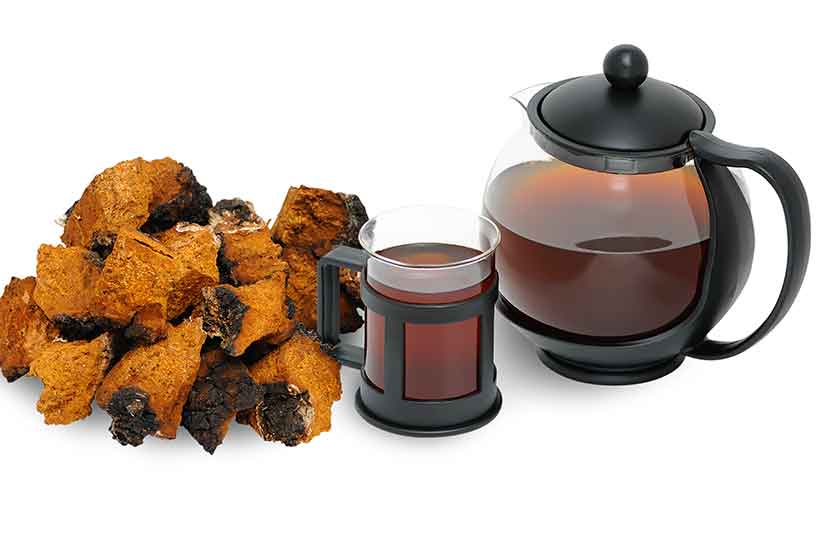
Many mushrooms have medicinal properties, but have you ever tried mushroom tea?
If not, you may want to look into chaga tea.
This particular drink originates in the Russian/Siberian region, and the ‘chaga’ mushroom is native to much of Northern and Eastern Europe, and Asia.
Chaga mushrooms are a type of fungus that grow on birch trees, and making them into tea simply involves boiling a piece of the dried mushroom.
It is a common daily drink in Siberia, and people believe it has important health and longevity benefits.
Is this belief backed by science?
Firstly, preliminary research into the potential benefits of the chaga mushroom seem interesting.
Some promising studies suggest that chaga tea extract has anti-tumor properties and may inhibit oxidative DNA damage in human cells (4, 5, 6).
However, these clinical trials tend to use higher concentrations of the mushroom than what you will find in the tea. There is also no high-level evidence (yet) that these effects occur in humans drinking the tea.
That said, the mushroom is full of phytonutrients, and it’s reasonable to suggest that drinking the tea will do our body good.
Key Point: Chaga tea is a dried mushroom infusion that is full of bioactive compounds. However, better evidence is needed to establish the benefits of drinking it.
4. Chai Tea

Chai is a combination of black tea, steamed milk, and various Indian herbs and spices.
These spices typically include cinnamon, cardamom, cloves, and ginger, among others.
Depending on the specific tea and spices used, the flavor of chai tea can vary quite a lot. However, it’s generally creamy, a little spicy, and it has a warming feeling while drinking it.
That said, the health properties of chai tea can be either positive or negative depending on where you drink it.
A traditional style chai tea is relatively healthy, but the Starbuck’s version comes loaded with 45g sugar (grange size).
Chai tea will provide much of the same benefits as black tea, with the high polyphenol content of the spices an added bonus.
Key Point: The traditional version of chai tea is good for you, but watch out for the high-sugar coffee shop versions.
5. Chamomile Tea
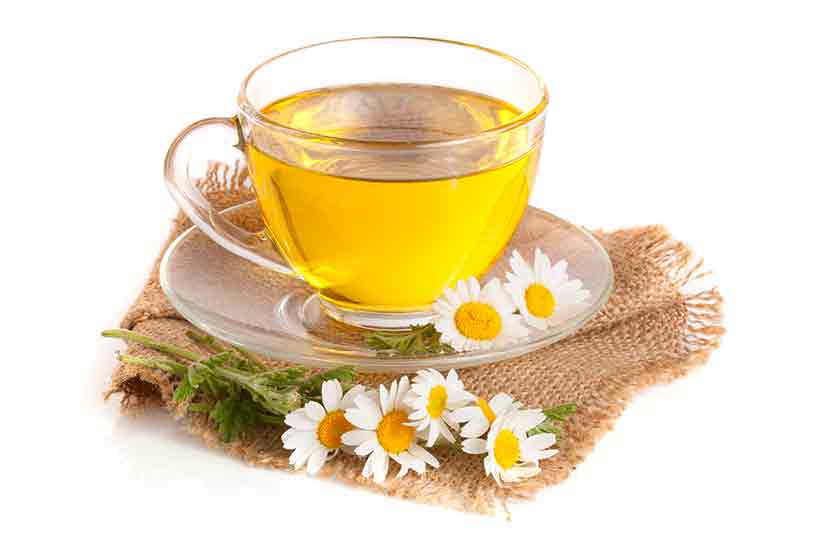
Chamomile tea comes from the edible flowers of the matricaria chamomilla plant, otherwise known as chamomile.
This particular drink has a reputation for being a good bedtime beverage, and manufacturers claim it helps to relax our body.
It is one of the most popular types of tea and it pairs a mild bitterness with a light, floral, and slightly sweet taste.
Research into chamomile demonstrates that it may function as a relaxant, and it also shows promise for helping to treat anxiety (7, 8, 9).
Furthermore, randomized controlled trials suggest that chamomile can help people to overcome sleep quality problems (10).
Key Point: Chamomile tea is light and easy to drink, and it appears to have a positive impact on anxiety/relaxation.
6. Chrysanthemum Tea

Chrysanthemums are flowering plants that originate in East Asia, and we can mainly find them in China.
The flowers of this family of plants can vary in color, but they are edible and we can cultivate their leaves to make chrysanthemum tea.
Like all flower teas, chrysanthemum has a floral aroma alongside a light and slightly sweet flavor.
Traditionally seen as a herbal medicine in the East, people believe the drink has anti-inflammatory properties.
However, although the tea contains various polyphenols, there is very little research to confirm the purported benefits (11).
Key Point: The Chinese see chrysanthemum extract as a medicinal drink, but further research is necessary. The tea is pleasant-tasting and enjoyable to drink.
7. Dandelion Tea
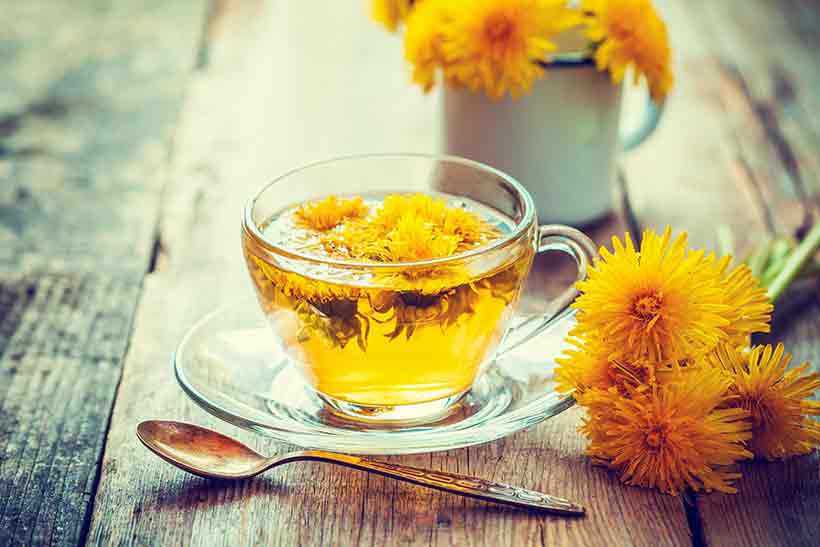
For those of you with a garden, you can probably spot some dandelions from time to time.
They grow almost everywhere, but did you know you can eat them too?
Dandelions are edible, and dandelion salads and dandelion tea are both popular options. Tea made from dandelion leaves is very light and mild, with a slight floral taste.
However, there is another dandelion drink known as ‘dandelion coffee’.
To make this particular “tea”, the production process calls for the roasting of the dandelion’s roots.
Interestingly, this drink looks (and tastes) a little bit like coffee, and some people even use it as a coffee substitute.
Much of the supposed health benefits of dandelion tea is as yet unproven by research, but limited studies (and anecdotal accounts) suggest it may have digestive benefits (12, 13).
Key Point: Dandelions tea is an alternative to regular tea AND coffee. It may have digestive benefits, but we need more research.
8. Essiac Tea

Essiac tea is a traditional drink of the Ojibwa, a North American Indian tribe also known as the Chippewa.
It has a slightly bitter, grassy kind of flavor. It’s not a tea I’d call enjoyable, but it doesn’t taste too bad either.
The big claim about this tea is that it can help to treat cancer.
A quick look at the evidence shows that the tea has anti-inflammatory and DNA-protective properties (14, 15).
However, the evidence for the tea being able to help with cancer is underwhelming.
There is one animal study showing that Essiac extract (in extremely high doses) may inhibit tumor cell growth (16).
But most importantly, there are no human studies that suggest Essiac can be an effective cancer treatment (17).
Key Point: If you want to drink Essiac tea, then drink it for the taste and its polyphenol content. It is probably better to ignore the marketing claims about cancer.
9. Green Tea

Another true tea, and one which has numerous evidence-based health benefits.
Green tea originated in China where it has been popular for millenia. While black tea is the popular choice in the Western world, green tea dominates the East, especially in Japan.
There are many different varieties of green tea too, some of which we will feature in this guide. The more popular kinds include sencha, genmaicha, and matcha.
Green tea is very healthy, and it is one of the most research-backed foods/drinks in the world.
Specifically, systematic reviews demonstrate that regular green tea consumption can reduce cancer risk, reduce blood pressure, reduce insulin resistance, and increase glycemic control (18, 19, 20).
Much of these beneficial properties come from the catechin content of green tea, which is a type of polyphenol.
Just one thing; watch out for the sugary latte versions of the drink in popular cafes. These should not be considered as healthy, and they usually contain 10+ teaspoons of sugar.
Key Point: Green tea is one of the oldest (and healthiest) drinks in the world.
10. Hibiscus Tea

Otherwise known as Agua De Jamaica, hibiscus is a tea made from the dried petals of the roselle flower.
Resembling the flower’s color, hibiscus tea is a dark blood-red, and it has a tart flavor and a flowery smell.
One of the reasons for the sour taste is the high acid content of hibiscus, with the tea containing malic, tartaric, citric, and ascorbic acids. In fact, the composition of hibiscus tea is 24% acidic (21).
Hibiscus supplies some decent nutritional properties too, and it is a good source of vitamin C and a variety of anthocyanin polyphenols.
A wealth of compelling research shows that hibiscus tea is effective at reducing both systolic and diastolic blood pressure.
Key Point: Hibiscus is a sour-tasting tea that is full of polyphenols. Notably, it has demonstrated blood-pressure lowering effects in a variety of high-level studies.
11. Matcha Tea
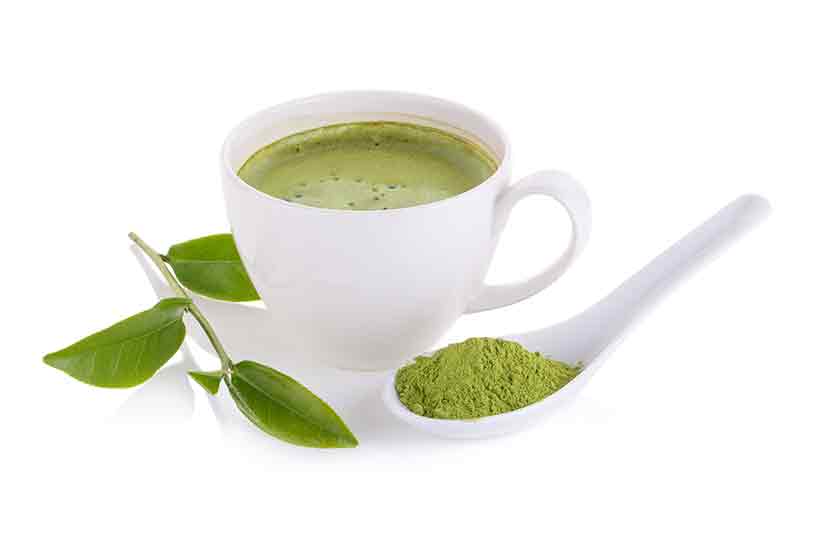
Matcha is a kind of premium Japanese green tea.
To make the drink, only the finest shade-grown tea leaves are picked, and then carefully ground into a fine powder.
Matcha is popular in Japan, where people tend to drink it in its pure state. The drink has a strong, bitter, and grassy taste.
However, (much of) the rest of the world mixes it with large amounts of sugar and steamed milk to make green tea latte.
Drinking matcha in this way is worlds apart from the pure ground leaves in terms of health benefits.
The benefits of regular green tea apply to matcha, but we can expect to amplify these benefits.
The reason for this is that we are actually consuming the leaves rather than just steeping them in water.
Key Point: Matcha green tea is a healthy drink with beneficial properties. However, the way you drink it is very important – the Western-style latte is very different to the traditional Japanese drink.
Enjoy tea? Then try some of these 25 tasty options!
12. Moringa Tea

The Moringa (moringa oleifera) plant sometimes goes by the name of ‘horseradish tree’ and it is native to the Himalayas in north-west India.The flowers, seeds, root, and leaves are all edible, and some Asian cultures use the leaves for culinary purposes.
It is also possible to make tea from the leaves, and this comes in both dried and powdered form. The tea itself has a light, grassy taste. It is quite mild and tastes somewhat similar to nettle tea.
Nutrient wise, it is a rich source of many essential vitamins and minerals – especially vitamin C and the B vitamins. There are claims that moringa tea has a host of health benefits too. Initial studies suggest that moringa may be useful as a therapeutic treatment for better control of blood-glucose and hyperlipidemia (excessively high triglycerides/cholesterol).
However, there is no high-level evidence in humans at this time, and further research is necessary.
Key Point: Moringa tea is a mild, earthy tea that may provide some useful health benefits.
Copyright © 2018 Hasnain Zaki. All Rights Reserved.











